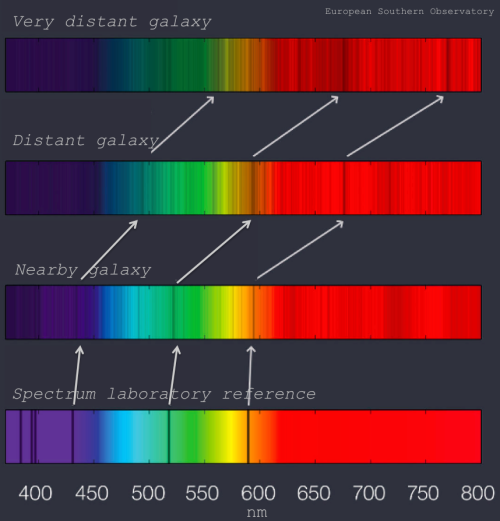REDSHIFT
Hi, I’m Marley, the Astronomer here at the Space Centre
In astronomy, nearly all of our information comes from light. ‘Light’ refers to any wavelength of light in the electromagnetic spectrum. From radio waves to gamma rays, astronomers are able to learn so much about astronomical objects based on the type of light observed from them. In this blog, I want to talk about one way astronomers use light to learn about an object: redshift.
Light behaves like a wave, and thanks to the Doppler Effect we know that when an object is moving, waves can either be squished together, or stretched. The Doppler Effect describes what happens to soundwaves. When an ambulance drives past you, the siren has a high pitch as it is coming towards you, and a lower pitch as it speeds away. When the ambulance is coming towards you, the soundwaves coming from the siren are compressed together. As it leaves, the soundwaves are spread apart. The same principle applies to light. Astronomers call it redshift when the object is moving away, and blueshift when it is moving towards us.
To detect redshift, astronomers use spectroscopy. This is the study of the absorption and emission spectra of light. When a material is very hot, it will emit light in a continuous spectrum. As an example, think of a rainbow. If that light passes through a gas cloud, atoms in that cloud will absorb specific wavelengths of light. The resulting rainbow we would see would have a gap of colour missing. This is an absorption line spectrum. Astronomers can also see emission line spectra, where the entire rainbow is black, and we only see lines of colours at specific locations. When an object is redshifted, those lines appear at longer wavelengths. Astronomers know where these lines appear when an object is stationary. To determine the redshift (z) of an object, astronomers look at the difference between the wavelength they see the spectral lines at, and where they should be. Objects with a larger z value are further away from us.

On smaller scales, redshift (and blueshift!) is the basis for the radial velocity method of detecting exoplanets. The subtle tug of the planet on the star makes it ‘wobble’. At times the light from the star appears to be ‘wobbling’ towards us, and in others it looks like it is ‘wobbling’ away, shifting to the blue and red ends of the spectrum respectively. On larger scales, redshift is used to measure the approximate distances to far away galaxies. In 1929, Hubble matched redshifts with distance estimates of galaxies and realized that the farther the galaxy is, the faster it is receding. This relation is called the Hubble-Lemaître law, and in this case, redshift is sometimes known as cosmological redshift. The galaxies are not really moving, instead the space between them is increasing due to the expansion of the universe.
Astronomer’s playlist
Time
Activity
30 mins
Astronomers use redshift to help determine the velocity of objects relative to Earth, and to find the distance to the object. In this NASA activity, you can calculate the redshift and velocity of supernova iPTF15th, and then use that information to calculate its distance from us on Earth.
Ask yourself: We see distant objects as redshifted due to the expansion of the universe. What would we see if the universe was not expanding? What if it was contracting?
30 mins
The Near Infrared Spectrograph (NIRSpec) on the James Webb Space Telescope (JWST) will collect the spectrum from some of the earliest galaxies in our universe. In this activity, you can be an astronomer and observe individual galaxies in the SMACS 0723 galaxy cluster. You can then collect and analyze the spectra.
Ask yourself: How are the spectra of the galaxies different? Which of the four galaxies is the youngest?
Here is an image of the SMACS 0723 galaxy cluster and the spectra of the four target galaxies. Notice the location of the spectral lines.
Ask yourself: Why does the second hydrogen line in the two lower redshift galaxies disappear from the last two? Is it actually gone?
30 mins
JWST is built to be able to see the first galaxies, and astronomers continue to find candidates for the earliest galaxy ever found. The JWST Advanced Deep Extragalactic Survey (JADES) team found four galaxies that appear to be unprecedentedly young. The universe would have been about 330 million years old!
Read the press release and take a look at the infographic here. One of the scientists is quoted as saying that sometimes close galaxies appear to be distant galaxies.
Ask yourself: How do you think that happens? How does analyzing the spectra of the galaxy give you information on if the galaxy is distant or close?

